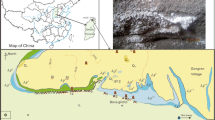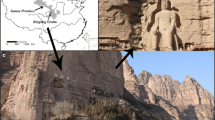Abstract
Yungang Grottoes in north of China are the classical masterpieces of Chinese Buddhists, dating from the Northern Wei Dynasty 1,500 years ago. This rock art is threatened by weathering processes that has been accelerated due to coal mining. The dominant weathering processes occurring on the rock surface are collapse, flaking, and efflorescence. Salt crystal growth plays a major cause of these deteriorations, and it has a close relationship with water movement. The major salt on the rock surface are sulfates, with a primary composition of epsomite, thenardite, and gypsum. In addition, carbonate minerals are found, mostly calcite and nesquehonite. In this paper, three grottoes in the eastern part have been investigated via measuring the rock surface moisture and recording the surface temperature and humidity. These nondestructive techniques are used for the first time in China on cultural relics. The movement of moisture has been calculated and mapped, and then analyzed for its relationship with the weathering process. Three main sources of water transport in the sandstone are adopted to explain the moisture content patterns. The aim of this study is to help rock art conservation in Yungang Grottoes, thus to provide a better understanding regarding the driving processes of internal moisture transport, which results in significant weathering processes. The evidence shows that the natural character of sandstone, water transport mechanism, and continental semi-arid conditions are the major causes of rock deterioration. Meanwhile, air pollution due to coal mining is also an important factor in driving the weathering process.







Similar content being viewed by others
References
Ahn Ho Seon, Lee Chan, Kim Joonwon, Kim Moo Hwan (2012) The effect of capillary wicking action of micro/nano structures on pool boiling critical heat flux. Int J Heat Mass Transf 55(1–3):89–92
Benito G, Machado MJ, Sancho C (1993) Sandstone weathering processes damaging prehistoric rock paintings at the Albarracín Cultural Park, NE Spain. Environ Geol 22:71–79
Bryan K (1928) Niches and other cavities in sandstone at Chaco Canyon, New Mexico. Z Geomorphol 3:125–140
Eklund Julie A, Zhang Hong, Viles Heather A, Curteis Tobit (2013) Using handheld moisture meters on limestone: factors affecting performance and guidelines for best practice. Int J Archit Herit 7(2):207–224
Goudie A, Viles H (1997) Salt Weathering Hazards. Wiley, Chichester
Griggs DT (1936) The factor of fatigue in rock exfoliation. J Geol 9:783–796
Hoerlé S (2005) A preliminary study of the weathering activity at the rock art site of game pass shelter (KwaZulu-Natal, South Africa) in relation to its conservation. S Afr J Geol 108:297–308
Hall Ch, Hamilton An, Hoff WD, Viles HA, Eklund JA (2010) Moisture dynamics in walls: response to micro-environment and climate change. Proc R Soc 1–18
Huang KZ (1984) Problems of sandstone sculpture weathering in Yungang Grottoes. Hydrogeol Eng Geol 3:32–35 (in Chinese)
Huang JZ (2003) Study on geological character in Yungang Grottoes. Southeast Cult 5:91–93 (in Chinese)
Lai WL, Tsang WF (2008) Characterization of pore systems of air–water–cured concrete using ground penetrating radar (GPR) through continuous water injection. Constr Build Mater 22:250–256
Meiklejohn KI (1997) The role of moisture in the weathering of the clarens formation in the KwaZulu/Natal Drakensberg: implications for the deterioration and preservation of indigenous rock art. S Afr Geogr J 79:199–206
Mol L, Viles HA (2010) Geoelectric investigations into sandstone moisture regimes: implications for rock weathering and the deterioration of san rock art in the golden gate reserve, South Africa. Geomorphology 118:280–287
Ollier CD (1963) Insolation weathering: examples from central Australia. Am J Sci 261:376–381
Paradise TR (2002) Sandstone weathering and aspect in Petra. Jordan Z Geomorphol 46:1–17
Puyate YT, Lawrence CJ (2000) Steady state solutions for chloride distribution due to wick action in concrete. Chem Eng Sci 55:3329–3334
Salmona Lynn G, Christoforou Christos S, Gerk Timothy J et al (1995) Source contributions to airborne particle deposition at the Yungang Grottoes, China. Sci Total Environ 167:33–47
Sass O (2005) Rock moisture measurements: techniques, results, and implications for weathering. Earth Surf Process Landf 30:359–374
Schaffer RJ (1932) The weathering of natural building stones. Garston (reprinted 1972)
The Third Team of Hydrogeology and Engineering Geology, Bureau of Shanxi Geology and Mineral, 1990. Engineering geological investigation and experiment report on water seepage prevention on the top of Yungang Grottoes
Tsypkin GG, Calore C (2003) Role of capillary forces in vapour extraction from low-permeability, water-saturated geothermal reservoirs. Geothermics 32:219–237
Turkington AV, Paradise TR (2005) Sandstone weathering: a century of research and innovation. Geomorphology 67(1–2):229–253
Viles HA, Goudie AS (2007) Rapid salt weathering in the coastal Namib desert: implications for landscape development. Geomorphology 85:49–62
Acknowledgments
Financial support was provided by the Ministry of Science and Technology of The People’s Republic of China (2009BAK53B02). We would like to thank the reviewers who read the first draft of this paper for their constructive comments. Special thanks to Prof. Heather Viles from University of Oxford for her insightful comments on this manuscript, Mr. Yik Yu Au from Institute of Karst Geology, Prof. Zhao Yaqian from University College Dublin for their help to improve the language of the paper, and Hong Zhang from University of Oxford for her technical support and very helpful comments.
Author information
Authors and Affiliations
Corresponding author
Rights and permissions
About this article
Cite this article
Guo, F., Jiang, G. Investigation into rock moisture and salinity regimes: implications of sandstone weathering in Yungang Grottoes, China. Carbonates Evaporites 30, 1–11 (2015). https://doi.org/10.1007/s13146-014-0191-8
Accepted:
Published:
Issue Date:
DOI: https://doi.org/10.1007/s13146-014-0191-8




